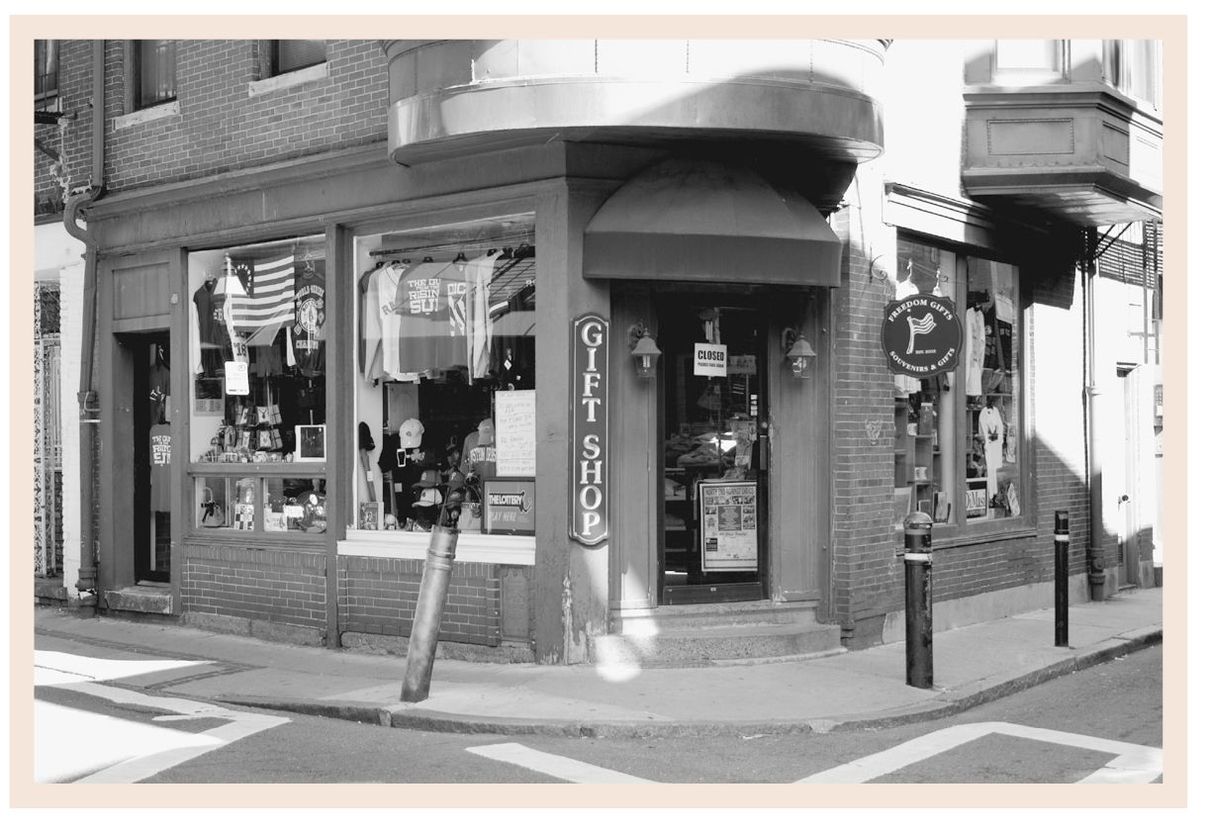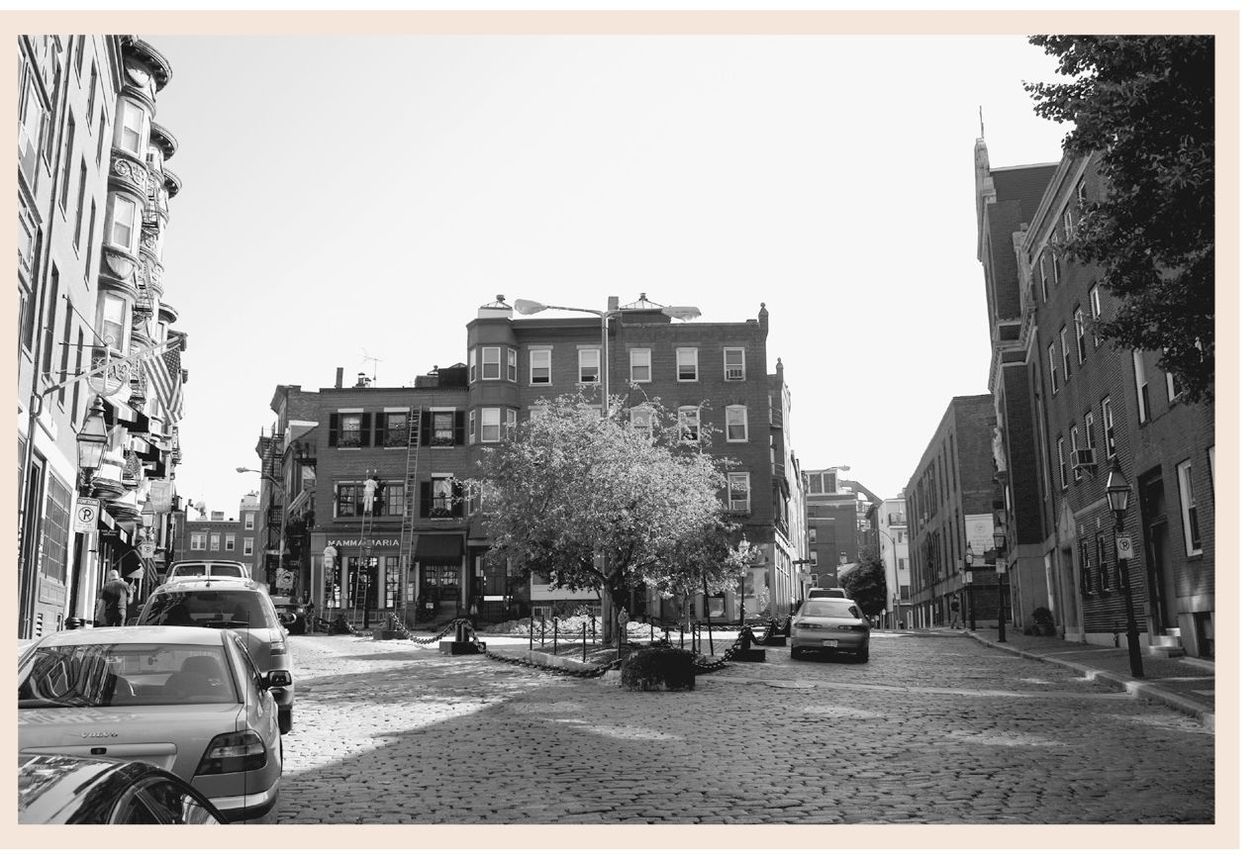CHAPTER 2
NORTH SQUARE

By 1895, the Paul Revere House had been occupied at various times by the Nazzaro Grocery Store on the first floor, a cigar factory, the Banca Italiana (the Italian Bank), and F. A. Goduti and Company. The house, the oldest house in Colonial Boston and built by Robert Howard around 1680, had been adapted to a vastly changed North Square since Paul Revere lived there in the late 18th century. The former home and silversmith shop had become used for commercial purposes a century later, and today this house museum attracts tourists from all over the world. (Author’s collection.)

The Pierce-Hitchborn House was built around 1711 by Moses Pierce, a glazier, and later occupied by Nathaniel Hitchborn, a local boatbuilder, and is a fine example of a three-story brick house of the early 18th century. Pierce’s profession as a glazier is evident in the large multipaned sash windows. Owned by the Hitchborn family from 1781 to 1864, it was saved from demolition in 1949 and today is the earliest surviving brick house in Boston. It is part of the Paul Revere House and is a house museum open to the public. (Courtesy Boston Public Library.)


Called “Little Italy” in the early 20th century due to the large concentration of Italian immigrants and their families, North Square was a bustling and vibrant area with shops, restaurants, and local institutions. Here about 1895, men stand and sit on the curbstone in front of the Banca Ettore Forte, a local banking institution, awaiting its opening. Once the site of the Old North Meeting House, which was demolished in 1775 and 1776 by British troops, the bank is today the site of the popular North End restaurant Mama Maria’s. (Author’s collection.)


In 1889, the corner of Prince and Moon Streets in North Square had the Alvino and Figlio New York–Boston Express office, which accepted freight being shipped between the two cities. A row of mid-19th century row houses can be seen on the right along Moon Street. The building today is Crosstown Art and an architectural office and has a prominent corner site facing North Square. (Author’s collection.)


Sacred Heart Church was established by the 1880s when the Society of St. Mark purchased the former Seamen’s Bethel, which was said to be a “quaint ship cabin looking church” by Walt Whitman in his book November Boughs. In 1911, the facade was remodeled and embellished with religious sculptures donated, and in some cases produced, by parishioners. On the far right are redbrick row houses of the mid-19th century. (Courtesy Vito Aluia.)


Looking from the area of what was once called “Mountford’s Corner,” North Square, by the early 20th century, had been built up with large four- and five-story buildings, including the Angelo on the left and the Mariners’ House just beyond the restored Paul Revere House. Revere and his family lived in North Square from 1770 to 1800 and were part of the thriving artisan community that made the North End a vibrant and busy place. (Author’s collection.)


The Grande and Son Barber Shop was at the corner of Prince and North Streets in North Square. The building, known as the MDC Building, was built in 1895 and has a prominent rounded bay. Seen standing in the doorway to this once popularly patronized barbershop (called a “sanitary shop” on the plateglass window) are Paul Grande on the left and his son Domenic Grande on the right; an unknown barber stands in the center. Today the Freedom Gift Shop is located here. (Courtesy Grande family.)


The Hotel Rome was a seven-story apartment building in North Square, at the junction of North Square and North Street. The hotel was demolished in the 1950s, and today the Rachel Revere Park is on the site. Named for Rachel Walker Revere (1755–1828), the second wife of Paul Revere, the park was restored in 1976 by the Massachusetts Charitable Mechanics Association. (Author’s collection.)


The Angelo was a four-story tenement building with pressed metal projecting bays flanking both sides of the facade and was a large apartment house for the new residents of North Square in the North End. On the far left is the Pierce-Hitchborn House, and on the right is a corner of the pre-restored Paul Revere House. The site is now an herb garden and the courtyard entrance to the two house museums. (Courtesy Boston Public Library.)


The Paul Revere House was restored to its presumed 17th-century appearance in 1907 by noted architect Joseph Everett Chandler for the Paul Revere Memorial Association. The house, although built around 1680, had been changed beyond recognition from its late-19th-century appearance during the restoration. Today the Paul Revere House is the oldest house in Colonial Boston and is a popular destination for tourists on the red-lined Freedom Trail. (Author’s collection.)
